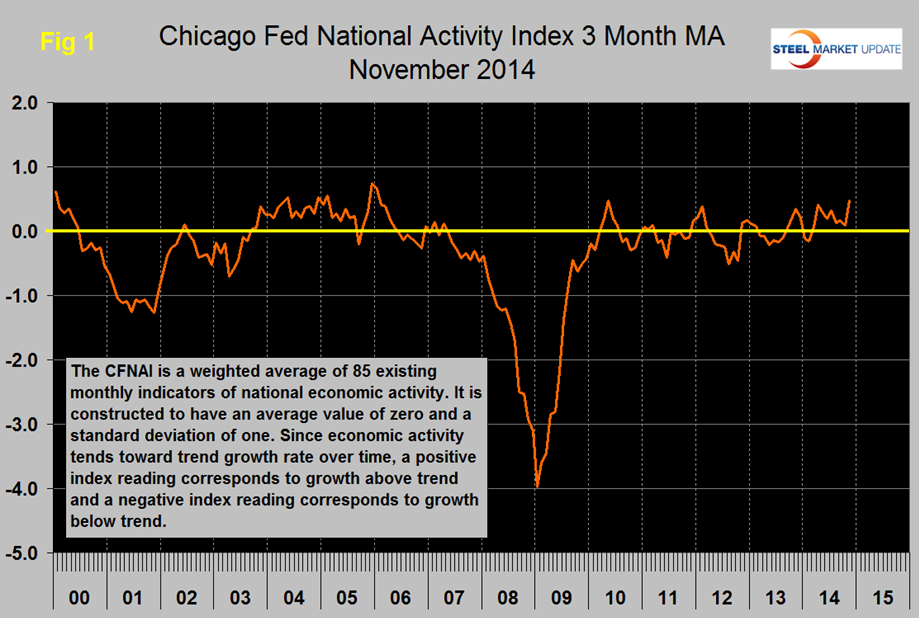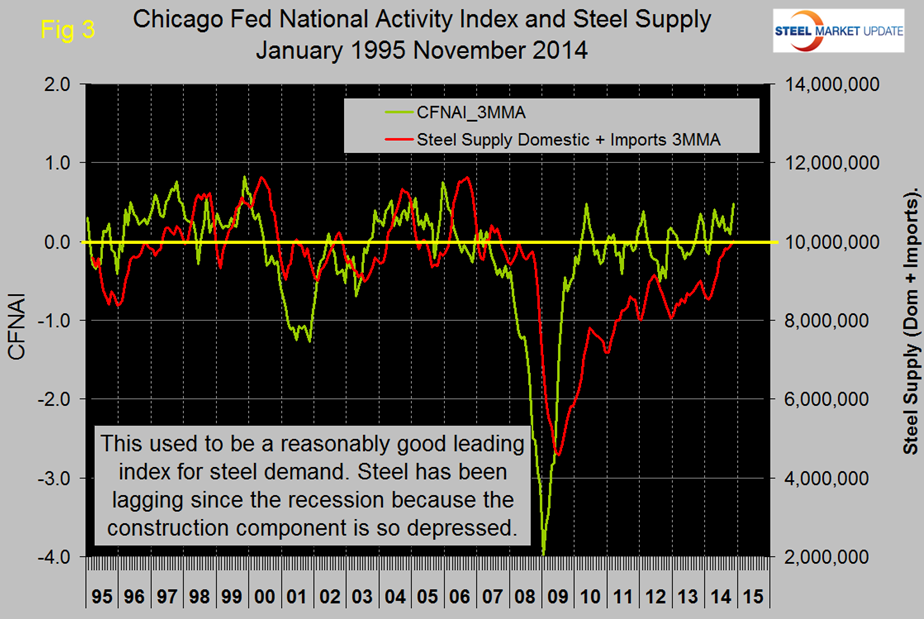Economy

The Chicago Federal Reserve National Activity Index and Steel Supply.
Written by Peter Wright
December 30, 2014
The following is the Chicago Federal Reserve statement followed by our own graphical analysis. The CFNAI is an excellent reality check for much of the economic analysis that we routinely provide in The Steel Market Update. An explanation of the Index is provided at the end of this piece.
Index shows economic growth picked up in November
“Led by improvements in production-related indicators, the Chicago Fed National Activity Index (CFNAI) rose to +0.73 in November from +0.31 in October. Two of the four broad categories of indicators that make up the index increased from October, and only one of the four categories made a negative contribution to the index in November.
The index’s three-month moving average, CFNAI-MA3, rose to +0.48 in November from +0.09 in October, reaching its highest level since May 2010. November’s CFNAI-MA3 suggests that growth in national economic activity was above its historical trend. The economic growth reflected in this level of the CFNAI-MA3 suggests modest inflationary pressure from economic activity over the coming year.
The CFNAI Diffusion Index, which is also a three-month moving average, increased to +0.37 in November from +0.18 in October. Fifty-four of the 85 individual indicators made positive contributions to the CFNAI in November, while 31 made negative contributions. Fifty indicators improved from October to November, while 35 indicators deteriorated. Of the indicators that improved, six made negative contributions.”
Production-related indicators made a contribution of +0.64 to the CFNAI in November, up from +0.09 in October. Industrial production increased 1.3 percent in November after moving up 0.1 percent in October, and manufacturing production increased 1.1 percent in November after moving up 0.4 percent in the previous month. In addition, manufacturing capacity utilization rose to 78.4 percent in November from 77.6 percent in October.
Employment-related indicators contributed +0.17 to the CFNAI in November, down somewhat from +0.22 in October. The unemployment rate remained steady at 5.8 percent in November, and average weekly initial unemployment insurance claims increased in November from October. However, non-farm payrolls increased by 321,000 in November, up from a gain of 243,000 in the previous month.
The contribution of the sales, orders, and inventories category to the CFNAI decreased to +0.02 in November from +0.11 in October.
The contribution of the consumption and housing category to the CFNAI increased to –0.10 in November from –0.11 in October. Consumption indicators, on balance, improved, pushing the category’s contribution higher. However, housing starts decreased to 1,028,000 annualized units in November from 1,045,000 in October, and housing permits declined to 1,035,000 annualized units in November from 1,092,000 in the previous month.
The CFNAI was constructed using data available as of December 18, 2014. At that time, November data for 51 of the 85 indicators had been published. For all missing data, estimates were used in constructing the index. The October monthly index was revised to +0.31 from an initial estimate of +0.14. Revisions to the monthly index can be attributed to two main factors: revisions in previously published data and differences between the estimates of previously unavailable data and subsequently published data. The revision to the October monthly index was due primarily to the former.”
Figure 1 shows the three month moving average of the CFNAI through November. There has been an erratic though sustained improvement since mid-2012. By this measure the economy is expanding faster than its historical trend, the November result at 0.48 equaled the result for May 2010, both of which were the best since December 2005.
Figure 2 shows the trends of the four main sub-components. The main reason for Novembers increase in the overall CFNAI was that the sub-component “Production and Income” shot up in November. The only negative of these four at present continues to be personal consumption and housing which had been trending up since Q2 2009 but has trended down slightly since February this year.
Figure 3 shows that the CFNAI has historically been a reasonably accurate leading indicator of steel demand, (apparent supply) with a lead time of about six months. This is one of several benchmark indicator that shows steel demand has not recovered to its traditional level since the recession. Steel demand is closing the gap but is still below the CFNAI benchmark. We believe this delayed response to be a measure of the extent to which construction, (or lack there-of) is still a drag on steel demand. The good news is that steel supply has been accelerating in the last few months, the bad news as we have reported elsewhere is that imports have taken most or all of that improvement.
Explanation: The index is a weighted average of 85 indicators of national economic activity drawn from four broad categories of data: 1) production and income; 2) employment, unemployment, and hours; 3) personal consumption and housing; and 4) sales, orders, and inventories. A zero value for the index indicates that the national economy is expanding at its historical trend rate of growth; negative values indicate below-average growth; and positive values indicate above-average growth. When the CFNAI-MA3, (three month moving average) value moves below –0.70 following a period of economic expansion, there is an increasing likelihood that a recession has begun. Conversely, when the CFNAI-MA3 value moves above –0.70 following a period of economic contraction, there is an increasing likelihood that a recession has ended. When the CFNAI-MA3 value moves above /+0.70 more than two years into an economic expansion, there is an increasing likelihood that a period of sustained increasing inflation has begun.

Peter Wright
Read more from Peter WrightLatest in Economy

New York state manufacturing index drops again in April
Firms were pessimistic, with the future general business conditions index falling to its second lowest reading in the more than 20-year history of the survey

Construction adds 13,000 jobs in March
The construction sector added 13,000 jobs, seasonally adjusted, in March, but tariffs could undermine the industry.

Supply chains, end-users brace for impact from tariffs
Supply chains are working through what the tariffs mean for them

ISM: Manufacturing expansion loses steam after two months of growth
US manufacturing activity slowed in March after two straight months of expansion, according to supply executives contributing to the Institute for Supply Management (ISM)’s latest report.

Chicago Business Barometer rose to 16-month high in March
The Chicago Business Barometer increased for the third-consecutive month in March. Despite this, it still reflects contracting business conditions, as it has since December 2023.



